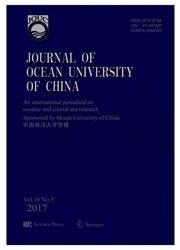

 中文摘要:
中文摘要:
The eutrophication,hypoxia and coastal acidification are attracting more and more attention.In this study,inorganic carbon parameters,including dissolved inorganic carbon (DIC) ,total alkalinity (TA) and calculated partial pressure of CO2 (pCO2) ,obtained from a summer cruise in August,2009,were used to investigate their integrated response to biological processes accompanying the oxygen depletion in the areas off the Changjiang Estuary.According to the observations,the typical hypoxia occurred in the bottom water just outside the Changjiang Estuary with Dissolved Oxygen (DO) lower than 2.00 mg L 1.The biological uptake in the surface water and the decomposition of organic matter in the bottom water were fully coupled with each other.The high concentration of Chl_a (Chl_a=10.9μg L 1) and DO (9.25 mg L 1) ,profoundly decreased DIC concentration (1828μmol kg 1) and elevated pH (8.42) was observed in the surface water.The correspondingly increased DIC and depletion of oxygen were observed in the bottom water.The semi-quantitative analysis proved that the locally-produced phytoplankton,determined by primary productivity,was deposited to the bottom and contributed about 76%of total amount of the organic carbon decomposition in the bottom.However,in the bottom hypoxia (DO=2.05 mg L 1) area observed in the Southern Zhejiang coastal water,the responding patterns of inorganic carbon parameters deviated from the previous one.The expanding of Changjiang Diluted Water (CDW) ,the adding of Hangzhou Bay water (with high DIC concentration) and Coastal Current together modify the DIC background value in this area,and the local degeneration and upwelling process may also help to offset the local DIC removed by net biological uptake in surface water.In addition,when the mixing occurring in autumn,which may break the summer stratification,the excess release of high DIC in the bottom water to the subsurface water could have an important influence on coastal acidification and the CO2uptake capacity in this area.
 英文摘要:
英文摘要:
The eutrophication, hypoxia and coastal acidification are attracting more and more attention. In this study, inorganic carbon parameters, including dissolved inorganic carbon (DIC), total alkalinity (TA) and calculated partial pressure of CO2 (pCO2), obtained from a summer cruise in August, 2009, were used to investigate their integrated response to biological processes accompanying the oxygen depletion in the areas off the Changjiang Estuary. According to the observations, the typical hypoxia occurred in the bottom water just outside the Changjiang Estuary with Dissolved Oxygen (DO) lower than 2.00 mg L^-1. The biological uptake in the surface water and the decomposition of organic matter in the bottom water were fully coupled with each other. The high concentration of Chl_a (Chl_a = 10.9μgL^-1) and DO (9.25 mgL^-1), profoundly decreased DIC concentration 0828 μmolkg^-1) and elevated pH (8.42) was observed in the surface water. The correspondingly increased DIC and depletion of oxygen were observed in the bottom water. The semi-quantitative analysis proved that the locally-produced phytoplankton, determined by primary productivity, was deposited to the bottom and contributed about 76% of total amount of the organic carbon decomposition in the bottom. However, in the bottom hypoxia (DO = 2.05 mgL^-1) area observed in the Southern Zhejiang coastal water, the responding patterns of inorganic carbon parameters deviated from the previous one. The expanding of Changjiang Diluted Water (CDW), the adding of Hangzhou Bay water (with high DIC concentration) and Coastal Current together modify the DIC background value in this area, and the local degeneration and upwelling process may also help to offset the local DIC removed by net biological uptake in surface water. In addition when the mixing occurring in autumn, which may break the summer stratification, the excess release of high DIC in the bottom water to the subsurface water could have an important influence on coastal acid
 同期刊论文项目
同期刊论文项目
 同项目期刊论文
同项目期刊论文
 Inorganic Carbon Parameters Responding to Summer Hypoxia Outside the Changjiang Estuary and the Rela
Inorganic Carbon Parameters Responding to Summer Hypoxia Outside the Changjiang Estuary and the Rela The impact of wind mixing on the variation of bottom dissolved oxygen off the Changjiang Estuary dur
The impact of wind mixing on the variation of bottom dissolved oxygen off the Changjiang Estuary dur Grain sizecomposition and transport of sedimentary organic carbon in the Changjiang River(Yangtze Ri
Grain sizecomposition and transport of sedimentary organic carbon in the Changjiang River(Yangtze Ri 期刊信息
期刊信息
